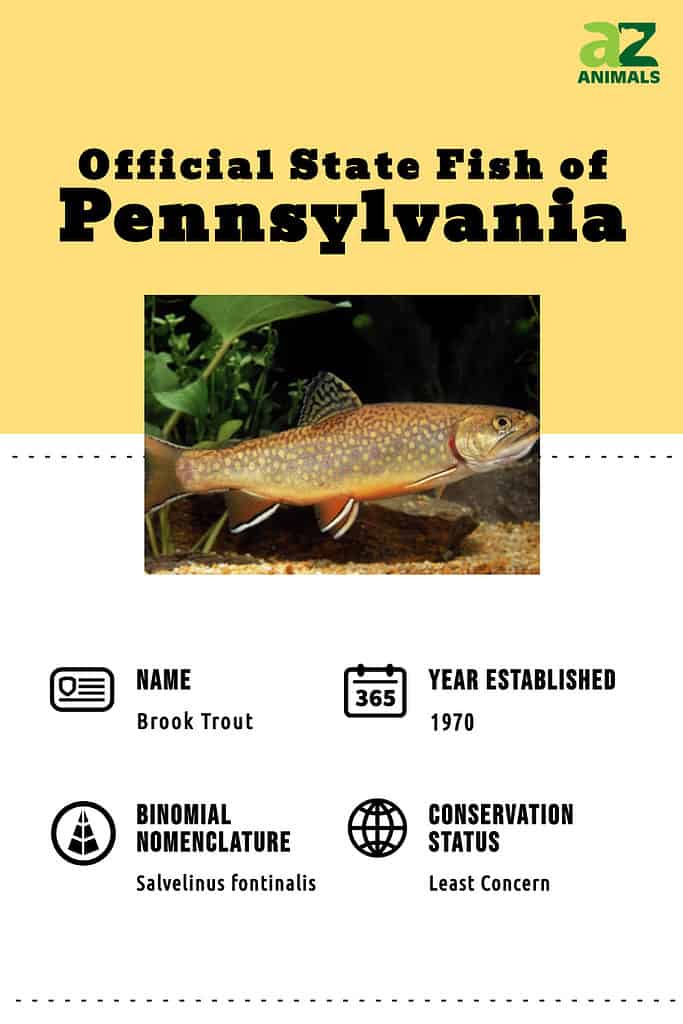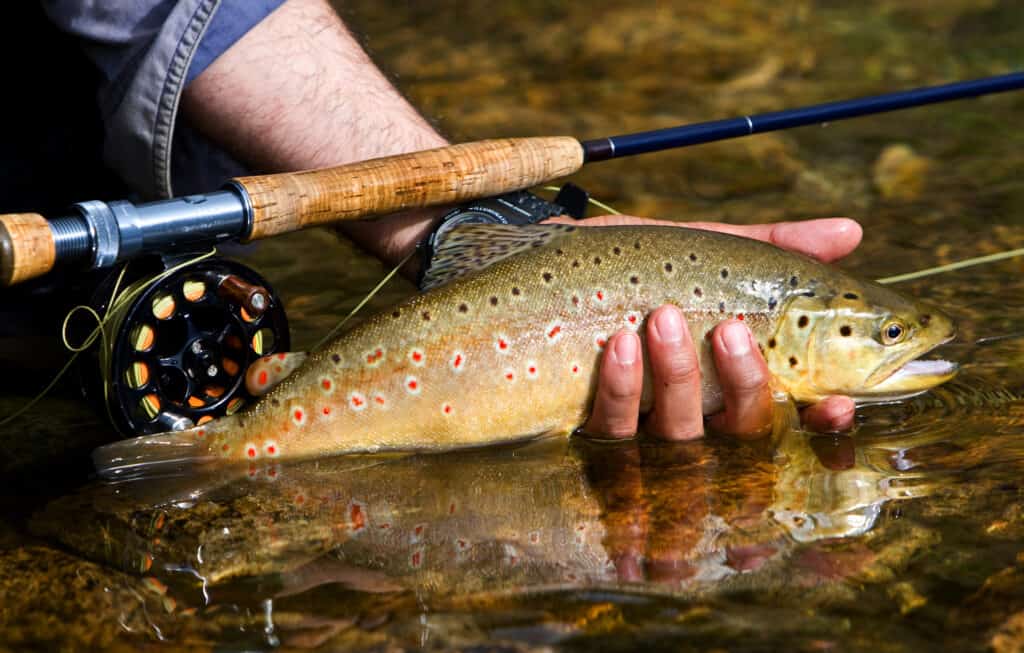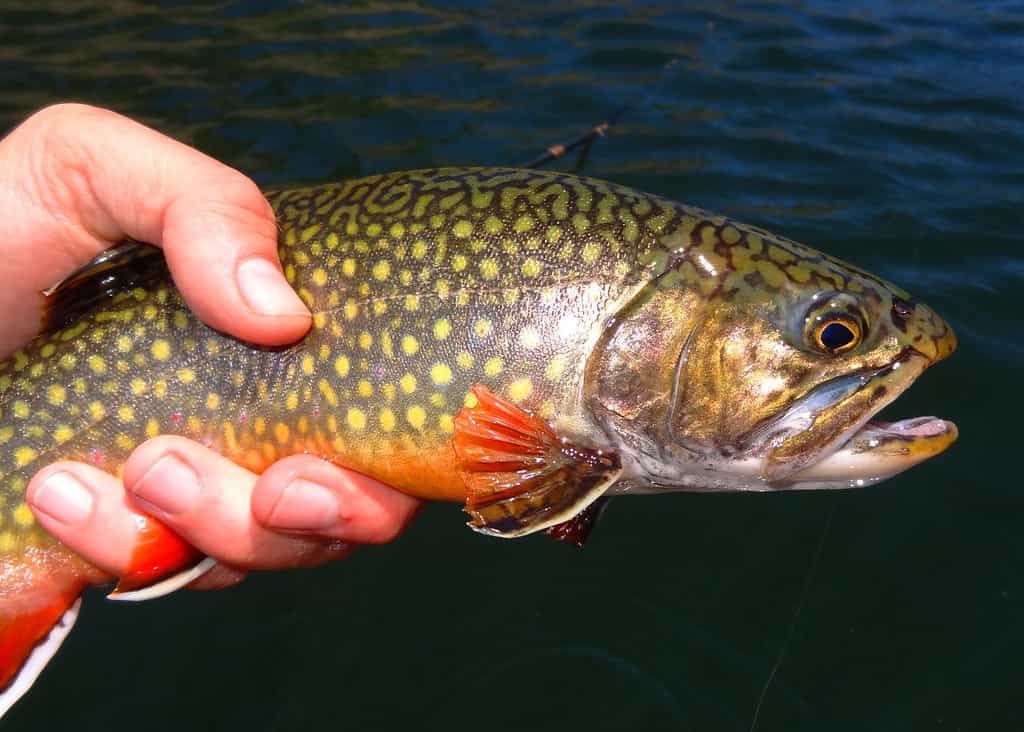Pennsylvania has six state animals — actually, seven if we include the extinct trilobite (Pennsylvania’s state fossil) in the list. A fish is counted among the Keystone State’s animal symbols. The official Pennsylvania state fish is the brook trout.

Legislation
The brook trout was named the official state fish of Pennsylvania on March 9, 1970. The legislation states,
“The Brook Trout is the only trout a native of Pennsylvania waters. A choice of most epicures, it is the most beautiful and widely distributed member of the salmon family in the State and is found in the small, cold mountain streams and lakes and in the spring-fed limestone streams of the valleys. The Brook Trout (Salvelinus fontinalis) is hereby selected, designated, and adopted as the official State fish of Pennsylvania.”
Brook Trout (Salvelinus fontinalis)
Appearance
The brook trout is not a true trout, but rather a char. True trout have a light color base with darker spots. Char, on the other hand, have a dark base with lighter spots. Brook trout are closely related to the Arctic char, lake trout, Dolly Varden, and bull trout.
Brook trout (or “brookies”) are among the most beautiful freshwater fish anywhere in the world. They are dark olive green with lighter yellow worm-like spots and specks (vermiculations) on its back. This gave rise to another common nickname for the fish: speckled trout.
The fish’s color transitions from olive green to orange-red along its sides, with bright red spots that are sometimes circled by a light blue halo. The lower fins are red or orange, and each has a white and black streak.
The brook trout has a large mouth and a rounded snout. It also has a broad, flat tail. The greater surface area of this tail gives the fish extra power to navigate the strong currents of the streams it inhabits. The tail also earned the fish yet another common nickname: the squaretail.
Brook trout typically grow from nine to ten inches long, though it is not unusual to find brookies over a foot long. Mature brook trout typically weigh one to two pounds.

Char, such as the brook trout, have a dark base color with lighter-colored spots and speckles.
©Dec Hogan/Shutterstock.com
Spawning and Lifespan
Brook trout spawn in the fall. In Pennsylvania, the spawn usually occurs in September and October. Brook trout fry typically emerge between February and April. These young brookies feed on zooplankton and tiny insects in the shallows until they grow large enough to move to deeper water and pursue larger prey.
Wild brook trout in Pennsylvania typically live two to three years. Fish in larger stream habitats may live up to six years.
Prey and Predators
Brook trout eat nymph and adult forms of aquatic insects. That list includes but is not limited to mayflies, stoneflies, and caddisflies. The fish will also feed on zooplankton, worms, crustaceans, and terrestrial insects such as ants and beetles. Larger brook trout will also prey on amphibians and smaller fish, including other brook trout.
Brook trout are food for various predators, including aquatic birds, northern water snakes, snapping turtles, and aquatic mammals such as otters.

Mayflies are among the brook trout’s favorite prey.
©Achkin/Shutterstock.com
Range
In the United States, the brook trout’s native range extends from the Great Lakes east to the Atlantic Ocean, down through the Appalachian Mountains, stretching as far south as Georgia, where they can be found in high-elevation streams.
An Ambassador of Clean Water
Brook trout have many nicknames, but one of the most ironic is “mud trout.” This moniker seems incongruous with the brook trout’s habitat. These fish require exceptionally cold, clean water to flourish. This led to the brook trout becoming a symbol of water quality throughout its native habitat.
Brookies prefer water from 57–60°F. Pollution typically raises water temperatures. If the water warms, brook trout will leave that waterway. Hence, the presence of brook trout is an indicator of the cleanliness and health of a water system.
The brook trout’s scientific name, Salvelinus fontinalis, alludes to this need for cold, clean water. Fontinalis is Latin for “of a fountain or spring.”

Brook trout require clean, cold water to thrive.
©United States Fish and Wildlife Services / Public domain – License
Threats to Pennsylvania’s Brook Trout
In a 2006 report, the Eastern Brook Trout Joint Venture reported that less than one percent of Pennsylvania’s historically wild native brook trout sub-watersheds were intact. Warming water and waterway segmentation have significantly harmed brook trout habitats throughout the state.
Also, non-native trout species have been introduced to the state’s waterways. Brown trout are not native to Pennsylvania. In fact, they are not even native to North America. But this European species is now the most common trout species in the state. These trout consistently outcompete native brook trout for food. Brown trout also prey on smaller brook trout.
Non-native rainbow trout have also been widely introduced to Pennsylvania waters. The International Union for Conservation of Nature lists both brown and rainbow trout in their list of the world’s 100 most harmful invasive species.
Wild native brook trout are listed as a species of greatest concern in the 2015-2025 Pennsylvania Wildlife Action Plan. However, in a rather scathing editorial, James Suleski argues that much more needs to be done to control non-native trout species.

Brown trout often outcompete native brook trout for food.
©iStock.com/MarceloDufflocqw
Brook Trout as an Invader
Ironically, while the brook trout of Pennsylvania are threatened by non-native trout, the trout itself is the invader in other parts of the country. For example, brook trout were introduced in some western states, and they are now threatening native species such as cutthroat trout. They were introduced into the waters of Yellowstone National Park in the late 1800s. Brook trout are now widespread in most of the park’s river drainages.
Fishing for Pennsylvania’s Brook Trout
Brookies are a favorite gamefish for anglers in the Keystone State, especially fly fishermen and fisherwomen. While brook trout are often quite small relative to other popular gamefish, they live in some of the most wild and scenic areas of the state. Catching one of these gorgeous native fish in such picturesque surroundings is the pinnacle of Pennsylvania fishing for many of the state’s anglers.
Sadly, the state’s brook trout population is barely a fraction of what it once was. The Pennsylvania Fish & Boat Commission offers an interactive map of the best wild trout waters in the state. Only six are listed as brook trout streams: Slate Run and Cedar Run in Lycoming County, Roaring Brook in Lackawanna County, Black Creek in Carbon County, Penns Creek in Mifflin County, and Fishing Creek in Clinton County. Brown Trout mainly dominate the rest of the streams listed. Some argue that even the streams that are listed as brook trout streams have small, if not extirpated, populations of brook trout.

Brook trout are a favorite of Pennsylvania anglers, but they are becoming more difficult to find.
©Matt Jeppson/Shutterstock.com
Brook Trout Records
The Pennsylvania state record brook trout measured 22 inches long and weighed seven pounds. Vonada Ranck of Watsontown caught this massive brookie in Fishing Creek in Clinton County.
The world record brook trout measured 31 inches long and weighed 14 pounds, 8 ounces. This monster was caught in Ontario’s Nipigon River on July 21, 1915.
Other States
Because of the brook trout’s connection with clean water, it has been named the state fish in nine states, the most of any fish species. Along with Pennsylvania, the brook trout is the official state fish of New Hampshire, Michigan, Virginia, New Jersey, New York, North Carolina, Vermont, and West Virginia. It is also the provincial fish of Nova Scotia, Canada.
The photo featured at the top of this post is © M Rose/Shutterstock.com
Thank you for reading! Have some feedback for us? Contact the AZ Animals editorial team.






